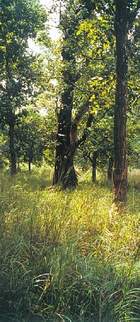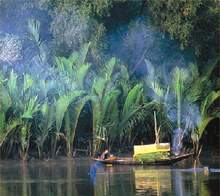Please View Sponsored Advertisements to Support this Site and Project
THE TYPES OF FORESTS IN BANGLADESH
Forestry is a sub-sector of agriculture in Bangladesh, which makes a contribution to the national economy and is supposed to promote ecological stability. Although Bangladesh is amazingly green, it is a forest-poor country. Most of its public forestlands are located in the Chittagong Hill Tracts, greater Khulna district, greater Sylhet district, Dhaka, Mymensingh and Tangail districts. Half of Bangladesh does not have public forests at all. Homestead forests seen around almost all households are important for the rural communities. They meet a significant portion of fuel wood need and house construction materials, among other things. Although it is estimated that Bangladesh has approximately 6% of its land covered with public forests, actually very little of natural forests is left today except for those in the Sundarbans in Khulna. The plantations are not to be considered as forests.
The moist or dry deciduous type of forest found in Dhaka, Mymensingh and Rajshahi districts have largely been depleted. In the Chittagong Hill Tracts patches of planted teak and rubber are often seen but solid patches of natural forest are hard to come by. In the coastal areas the mangrove forests are under threat, mainly due to prawn and shrimp aquaculture. The complete destruction of the Chokoria Sundarban, a unique patch of mangrove forest, due to export-oriented prawn aquaculture is a manifestation of the immense threat to the mangroves, the home of the Bengal Tigers.Officially the Forest Department of Bangladesh is supposed to manage around 2.6 million hectares or 18 per cent of the land surface of the country. This is a land mass recorded as forestland when the Forest Act of 1927 came into being. However, according to the Forest Department's latest information it now controls 10.3 per cent of land surface (Forest Department 2001). The largest category of the forests of Bangladesh are "reserved forests" which include the Sundarbans(mangroves) in the southwest, the Chittagong region in the southeast and the Modhupur tracts in the north-central region. The much smaller category of forest is the protected forests. The basic difference between the reserved and the protected forests is that the inhabitants in the reserved forest areas have no rights over the forest products but in the protected forests they have far more rights. In many cases the protected forest is an intermediate category that eventually turns into reserved forest.
The last category of forest is the unclassed state forest(USF), most of which are in the Chittagong Hill Tracts(CHT). 'Village common forests' managed by the indigenous people in the CHT include substantially forested portions of the USF lands.
The three main types of public forests are:
(i) Tropical evergreen or semi-evergreen forest in the eastern districts of Chittagong, Cox's Bazar, Sylhet, and the Chittagong Hill Tracts region; (ii) moist or dry deciduous forests also known as sal (Shorea robusta) forests located mainly in the central plains and the freshwater areas in the northwest region; and (iii) tidal mangrove forests along the coast - the Sundarbans in the southwest of the Khulna and other mangrove patches in the Chittagong, Cox's Bazar and Noakhali coastal belt.< /p> The Chittagong Hill Forest
i) The Chittagong Hill Forest have been broadly classified as the tropical evergreen or semi-evergreen types, which, according to a source, supply around 40% of the commercial timber. The flora of the Chittagong Hill Tracts is distinctive in character and resembles the flora of Arakan. However, the teak patches that we see throughout the CHT are planted forests, not indigenous to the CHT.
The most important commercial timber species of the Chittagong Hill Tracts used to be Jarul, Gamar, Garjan, Chapalish, Toon, Koroi, Civit, Champa, Simul, Chandul, etc. that used to grow to gigantic proportions. Most of the trees are of the evergreen type, whereas most of the tallest trees are deciduous and semi-deciduous. Some of the trees shed their leaves during the cold season and some in the summer, so the forest always looks green or, more correctly, the forest never loses its semi-evergreen appearance. However, this is a description of the forests of which very little remains today.
Apart from evergreen and deciduous forests, bamboo and savannah are of immense economic and environmental value. The most important industrial use of bamboo is as raw material for the Karnaphuli Paper Mill (KPM). Millions of tons of bamboo and softwood have been cut to feed the Mill, founded in 1953, at Chandraghona. Bamboo is still important item for people who live in the hills. But it is much less available today and the way the CHT landscapes are changing with commercial plantations (rubber and pulpwood), the bamboo is bound to become scanty for the hill people.
Bamboo the life blood of the people: Alarm to Ecosystem
Savannah type of forests are those where there are practically no trees and the areas are invaded by Sungrass. A very large portion of the Unclassed State Forest come under this category. It is not only the trees and mountains that dominate the Chittagong Hill Tracts - the fauna also makes the area different. The wild and mighty elephant is one particular attraction of the CHT. Bison, sambur, barking deer, leopard, Bengal Tiger, panther and other animals have disappeared or been drastically reduced in number today. Tigers are totally extinct in the CHT jungle. Attractive CHT birds species include the Imperial pigeon, Green pigeon, White winged wood-duck, Moina, Bhimraj, etc.
Human intervention through the Kaptai Hydroelectric Project and plantations has changed the landscapes and original features of the CHT forest. Teak, a commercially valuable tree, has been planted in the CHT, but it has been proved to be ecologically unsound, especially when planted as monoculture in patches. It taxes the soil too much. Teak, a deciduous species, increases fire hazards and is susceptible to be attacked by teak defoliators and the teak canker insects. Rubber plantation, a fairly new project undertaken by the Bangladesh Forest Industry Development Corporation(BFIDC), has not been proved to be environmentally and economically successful. This has played a big role in hastening deforestation and changing the natural features of the CHT forest.
One recent prime concern in the CHT is the expansion of the reserved forest. There has been further expansion of reserved forests by gazette notifications under the Forest Act, which has caused tension. According to an estimate of the Committee for the Protection of Forests and Land Rights in the Chittagong Hill Tracts, between 1990 and 1998 the government declared 217,790.3 acres of land from 83 Mouzas in the three hill districts as reserved forests. Of these, 140,341.31 acres had been finally notified as reserved forests. However, a BBC Radio broadcast quoted a high official in the Ministry of Environment and Forest (MoEF) saying that 208,148 acres had been primarily notified as reserved forest of which 116,880 acres had been finally notified. ii) The traditional sal forest used to extend over Modhupur tract as well as over the districts of Dhaka, Rangpur, Dinajpur and Rajshahi. However, today the remnants of the sal forest are not representative of the traditional sal forest. Most of the sal forest has been denuded, degraded and encroached upon or taken over for commercial or industrial plantation of rubber or fuelwood along with exotic species. The Modhupur sal forest , the largest sal forest patch in the country, represents the critical conditions that the sal forests face today.
(ii) Moist or dry deciduous forests
In the sal forest 70% to 75% of the trees used to be the sal. But today the sal forest patches have been exhausted to such a great extent that in most places they no more represent the traditional sal forests. A traditional sal forest has some unique features. The soil all over a sal forest looks yellowish or reddish in color. In the Modhupur forest, mixed with the yellowish red sandy clay is scattered manganiferous iron ore, commonly called Modhupur Kankar.
In addition to its commercially valuable sal tree, this forest has other valuable trees such as koroi, chambal, jogini, chakra, kaikha, amlaki, ajuli and gadila.
iii) The mangrove forest, the Sundarbans
The mangrove forest, the Sundarbans in the southwest of Bangladesh, is unique because of its history, size, productivity and significance in balancing the local ecosystem. It is the largest mangrove patch in the world - the second largest (in Malaysia) is only one-tenth of its size. W.W. Hunter's description depicts a picture of its original size and uniqueness: "The Sundarbans have an extreme length along the sea face of the Bay of Bengal, from the Hoogli to the Meghna, of about 165 miles, the greatest breadth from north to south being about 81 miles". Despite official land reclamation programmes and continued exploitation of products from this swampy forest, it still survives with multiple threats originating from the modern world.
With hundreds of morasses, swamps (many of which have gradually filled up), estuaries, large and small rivers, canals, creeks, which interlace with each other, the Sundarbans is "dangerous-looking". In darkness it is an impossible territory to venture into. More than a century and quarter ago W.W. Hunter described the Sundarbans as " a tangled region of estuaries, rivers and watercourses, enclosing a vast number of islands of various shapes and sizes."The Sundarbans has changed since then but his description is still relevant.
The Bangla name for the Sundarbans is Shundar Bon (beautiful forest). The name has perhaps been given because the most common tree in the Sundarbans is Sundari (Heritiera fomes), which provides a heavy but excellent timber. However the exact origin of the name is hard to determine. Both estuarine and swampy, this forest is below the mean high tide level and the major part goes under water during the rising tide. Everyday the tidal water sweeps the whole forest twice.Categorised as "Reserved Forest", the Sundarbans, unlike mangroves in many other countries in Asia, Africa and Latin America, is an important source of forestry products and fish. It is very important for the local and national economy. It was producing about 45% of the total timber and fuel wood output in the 1980s (Hussain and Acharya, 1994). The Khulna Newsprint Mill is dependent on the raw materials from the Sundarbans.
W.W. Hunter gave a list of 30 principal kinds of timber found in the Sundarbans including the Sundari. Some of them are Bain, Amur, Bali, Bhara, Bonjam, Garan, Kankra, Pasur Gewa, and Sondal. The major trees are found in varied quantity in different zones of the Sundarbans. The forest is also the source of other house construction materials such as Golpata and sungrass, used for making roofs of the local houses. Honey, bees-wax, crustaceans and molluscs are other resources regularly harvested from the Sundarbans. More than 120 fish species are harvested in the mangrove area.
Quite a large population depend directly or indirectly on the Sundarbans. According to an Escap survey, 500,000 to 600,000 people depend directly on the Sundarbans for their livelihood. This large population includes commercial and industrial enterprises dependent on the forest products. The Sundarbans is not only important for economic benefits per se, it also provides protection against coastal erosion and cyclones (Philip Gain, The Holiday, August 16, 2002 )
1. The forest boss who gobbled up trees: all old trees of the forests of the country have almost vanished Top of page
Back to Home Garden
Home

